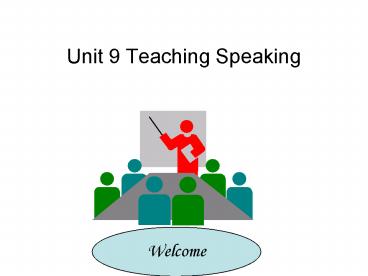Unit 9 Teaching Speaking PowerPoint PPT Presentation
1 / 18
Title: Unit 9 Teaching Speaking
1
Unit 9 Teaching Speaking
Welcome
2
Teaching Objectives
- 1.The purpose of learning speaking
- 2.Two main factors affect the improvement of
speaking ability - 3. Characteristics of spoken language
- 4. Principles for designing speaking
activities - 5. Group work in speaking activities
- 6. Common types of speaking activities.
3
I. The purpose of learning speaking
- 1.Speech is the basic medium of
- communication
- 2.To train students oral ability
- 3.To foster students talent in English
- language and culture
- 4.To foster students ability of thinking in
- English
4
- 5. Learning speaking can accelerate the
- learning of listening, reading and
- writing in English.
5
II. Two main factors affect the improvement of
speaking ability
- 1. Surroundings
- 2. Psychology.
6
III. The characteristics of spoken language
- Speaking is the skill that the students will be
judged upon most in real-life situations. It is
an important part of everyday interaction and
most often the first impression of a person is
based on his/her ability to speak fluently and
comprehensibly. So, as teachers, we have a
responsibility to prepare the students as much as
possible to be able to speak in English in the
real world outside the classroom and the testing
room.
7
- 1. Speaking is a skill, just like swimming,
driving a car, or playing ping-pong. Too often,
in the traditional classroom, the learning of
English has been relegated(???)to linguistic
knowledge only, e.g. knowledge of vocabulary and
grammar rules, with little or no attention paid
to practising language skills. How can we tell
the difference between knowledge and skill?
Bygate (19874) points out one fundamental
difference is that both can be understood and
memorized, but only a skill can be imitated and
practiced.
8
- 2. Speech is spontaneous. That is, in most
situations, people do not plan ahead of time what
they are going to say. Only in more formal
situations, such as when a person has been asked
to give a speech, do people plan and organize
their speech. The fact that speech is spontaneous
means that it is full of false starts,
repetitions, incomplete sentences, and short
phrases. So, should we expect the students to
produce complete sentences in the language
classroom? Bygate (19878) points out that
teachers may be requiring their students to do
more forward-thinking and planning than native
speakers do in real life!
9
- 3. Producing spoken language is the
time-constraint. The students must be able to
produce unplanned utterances in real time,
otherwise people will not have the patience to
listen to them.
10
- TASK 1
- Which of the following activities do you think
would help to prepare students for real life
speech in English? - 1.reading aloud
- 2.giving a prepared talk
- 3.learning a piece of text or dialogue by heart
- 4.interviewing someone,
- or being interviewed
- 5.doing a drill.
11
IV. Designing speaking tasks
- Maximum foreign talk
- Even participation
- High motivation
- Right language level
12
V. Using group work in speaking tasks
- Using small group work because it increases the
time for each student to practise speaking in one
lesson. - Students are often afraid of criticism or losing
face or they simply feel shy about speaking in a
foreign language in front of a whole class.
13
V. Using group work in speaking tasks
- 3. Different small groups can work at different
levels. - 4. Small group work helps students learn to work
cooperatively and it helps them develop
interpersonal skills.
14
VI. Types of speaking tasks
- Information-gap activities
- Dialogues role play
- Activities using pictures
- Problem solving activities
- Other speaking activities
- Find someone who
- Bingo Activities
- Change the story
- No specific responses
15
VII. Conclusion
- The trick in teaching speaking is to provide a
chance for students to speak and make them speak.
- It is best to keep the teachers talk at a
minimum level. - Students should not be forced to speak when they
are not ready yet.
16
VII. Conclusion
- 4. Designing speaking activities that maximize
students opportunity to speak is one of the
central tasks for language teachers. - 5. To think of more creative ways to give the
students as much time to practise speaking as
possible.
17
VIII. Assignments
- 1. Do all the exercises in the text
- 2. Read Chapter 4 of TLBCE
- 3. Prepare a class of 5 minutes of teaching
speaking.
18
Thank you ! Good bye !

